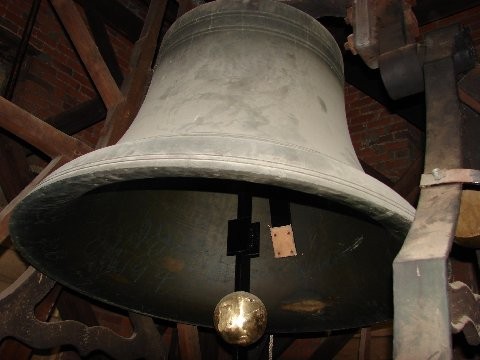
In May, 1856, the Fredericksburg News reported that the 1,510 pound bell for St Georges was “elevated to its position” into the steeple. That implies a hoist or lift but given no modern cranes or helicopter at the time it was still a job. Did it go through the middle of the Church or on the outside through the louvres? (Our current bell company believes the latter). However, just two years later the Church felt that bell’s sound was deficient.
In July, 1858 a new bell from Meneely Bell Foundry had been ordered and finally arrived, this one weighing 8,000 pounds with a tone that was a “decided improvement” from the first one. It would be the largest bell in town. I say “finally” since the bell was originally sent to Richmond by steamer instead of Fredericksburg. (I am hoping you didn’t have delivery problems that bad over the recent holiday). The paper quipped that the captain of the steamer displayed “an acquaintance with the geography of Virginia worthy of a member of the last legislature.”
The weight was overstated in weight. Actual weight is 2,500 pounds
In 2009,we received a gift from a couple at St. George’s to repair the St. George’s Bell.
The bell was made in Troy by the Meneely Company and was installed in July, 1858. It was the third bell at St. George’s and was the largest bell at the time in Fredericksburg.
The bell has not been tolled since 2007 due to lack of support in one of the U bolts at the top of the bell. If not corrected, tolling could jeopardize the integrity of the support mechanism. Tolling is distinguished from striking the bell on the outer surface which does affect the support. The bell is currently stuck on the outside on the hour and half hour in sync with the clock.
There are other issues associated with the bell besides the bolts. The original 1858 clapper is worn due to use. A leaf from the clapper spring is completely missing. The spring prevents the clapper from resting against the bell and dampens the vibrations allowing a consistent strike. As the bell swings, the clapper falls down and pushes through spring and strikes. The spring pulls the bell off so it can ring again and also takes out the force of the clapper striking. If the spring does not function, the clapper could crack the bell by not taking away the sound waves. The clapper will be repaired but the clapper spring will have to be replaced. Finally, a new headpiece is required. The headpiece secures all the internal hardware and bell to the yoke assembly.
Verdin repaired the bell and it tolled at Easter, 2009. We were able keep as much of the original bell intact (clapper) while reluctantly replacing some of the structural items (clapper spring, headpiece) to keep a functioning bell. The picture shows the bell after repairs in April, 2009
